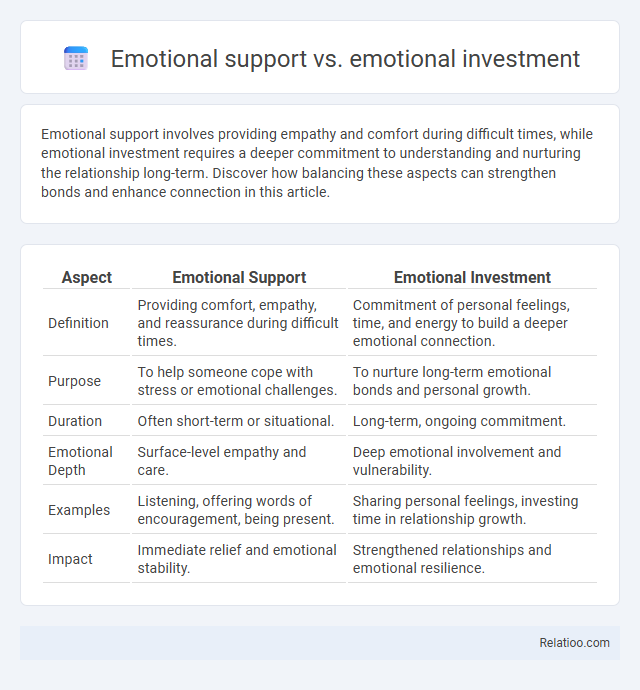Emotional support involves providing empathy and comfort during difficult times, while emotional investment requires a deeper commitment to understanding and nurturing the relationship long-term. Discover how balancing these aspects can strengthen bonds and enhance connection in this article.
Table of Comparison
| Aspect | Emotional Support | Emotional Investment |
|---|---|---|
| Definition | Providing comfort, empathy, and reassurance during difficult times. | Commitment of personal feelings, time, and energy to build a deeper emotional connection. |
| Purpose | To help someone cope with stress or emotional challenges. | To nurture long-term emotional bonds and personal growth. |
| Duration | Often short-term or situational. | Long-term, ongoing commitment. |
| Emotional Depth | Surface-level empathy and care. | Deep emotional involvement and vulnerability. |
| Examples | Listening, offering words of encouragement, being present. | Sharing personal feelings, investing time in relationship growth. |
| Impact | Immediate relief and emotional stability. | Strengthened relationships and emotional resilience. |
Understanding Emotional Support: Definition and Importance
Emotional support involves providing empathy, care, and reassurance during difficult times, helping to alleviate stress and promote mental well-being. Emotional investment goes beyond support by requiring a deeper commitment of your feelings, time, and energy into a relationship or cause. Understanding the importance of emotional support highlights its role in fostering trust, resilience, and stronger interpersonal connections.
Defining Emotional Investment: What Does It Entail?
Emotional investment involves committing significant psychological energy and vulnerability towards a person, relationship, or goal, reflecting a deep level of involvement and care beyond surface-level feelings. Unlike emotional support, which primarily offers comfort during challenging times, emotional investment requires ongoing dedication, trust, and the willingness to endure potential risks for emotional growth or success. Understanding emotional investment entails recognizing its impact on personal development, relationship dynamics, and long-term emotional well-being.
Key Differences Between Emotional Support and Emotional Investment
Emotional support involves providing comfort, understanding, and reassurance to someone during difficult times, focusing on responding to their emotional needs without personal attachment. Emotional investment, in contrast, refers to the degree of personal commitment and emotional energy you put into a relationship, reflecting deeper involvement and long-term attachment. Understanding these key differences helps you navigate relationships by recognizing when to offer empathy versus when to engage more profoundly for mutual growth.
The Role of Boundaries in Healthy Emotional Connections
Healthy emotional connections require clear boundaries to distinguish between emotional support and emotional investment. Emotional support involves offering empathy and comfort without overextending your own emotional resources, while emotional investment means deeper involvement that demands careful boundary setting to prevent burnout. Establishing these limits helps you maintain balance, protect your well-being, and foster sustainable, meaningful relationships.
Emotional Support: Benefits for Relationships and Well-Being
Emotional support enhances your relationships by fostering trust, empathy, and resilience during challenging times. It contributes significantly to mental well-being, reducing stress and promoting a sense of security and belonging. Prioritizing emotional support over emotional investment helps maintain healthy boundaries while still nurturing meaningful connections.
When Emotional Investment Becomes Unhealthy
Emotional investment becomes unhealthy when personal boundaries blur, leading to emotional dependency or neglect of self-care, often causing stress and anxiety. Unlike healthy emotional support, which encourages resilience and mutual growth, excessive emotional investment may result in imbalance and emotional exhaustion. Recognizing signs such as constant worry, loss of identity, or one-sided relationships helps prevent emotional burnout and fosters healthier connections.
Balancing Emotional Support and Emotional Investment
Balancing emotional support and emotional investment requires understanding that emotional support involves providing empathy and reassurance during challenging times, while emotional investment reflects the depth of personal attachment and commitment within relationships. Striking a balance ensures that support is given without overextending oneself emotionally, preserving mental well-being and fostering healthier, more sustainable connections. Effective emotional management allows individuals to maintain boundaries, avoid burnout, and nurture reciprocal, meaningful relationships.
Signs You’re Over-Investing Emotionally
Signs You're Over-Investing Emotionally include feeling drained, constantly anxious about others' reactions, and neglecting your own needs in relationships. Emotional support involves providing comfort and understanding, while emotional investment means committing time and energy to nurture connections; over-investment occurs when this commitment becomes unbalanced and hurtful. Recognizing these signs helps You protect your well-being and maintain healthy emotional boundaries.
How to Foster Healthy Emotional Support Without Over-Investing
Healthy emotional support involves active listening and empathy without depleting your own emotional resources, ensuring balance in relationships. You can foster this by setting clear boundaries, recognizing your limits, and practicing self-care to prevent emotional burnout. Prioritizing mutual respect and open communication helps maintain emotional investment while avoiding over-investing that leads to dependency or exhaustion.
Practical Tips for Navigating Emotional Support and Investment
Effective navigation of emotional support and emotional investment requires clear boundaries and self-awareness to prevent burnout and maintain healthy relationships. Prioritize open communication to express needs and limits, ensuring mutual understanding and reducing emotional strain. Use practical strategies such as setting time limits for support, balancing empathy with self-care, and regularly assessing the emotional return on investments to foster sustainable connections.

Infographic: Emotional support vs Emotional investment
 relatioo.com
relatioo.com